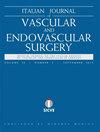Analysis and results of pharmacomechanical thrombectomy with AngioJet in acute arterial occlusions: a prospective comparison study among the number of cycles and outcomes
IF 0.2
Q4 PERIPHERAL VASCULAR DISEASE
Italian Journal of Vascular and Endovascular Surgery
Pub Date : 2023-10-01
DOI:10.23736/s1824-4777.23.01588-7
引用次数: 0
Abstract
BACKGROUND: The main objective of this present paper was to evaluate the results and outcomes of patients with acute limb ischemia (ALI) submitted to pharmacomechanical thrombectomy (PMT) endovascular surgery, regarding the number of cycles of PMT, mainly the limb salvage estimates rate and the overall survival rate, performing a comparison with patients with ALI according to the number of cycles performed during PMT technique.METHODS: Overall, 92 patients with ALI submitted to PMT were evaluated. Two groups of patients were identified: group 1 higher than 150 cycles with 60 patients and group 2 lesser than 150 cycles with 32 patients.RESULTS: The overall mortality rate (OMR) was 15.1% (13 patients) in total cohort within the first 30 days. Group 1 had a higher OMR than group 2 (16.1% versus 9.3%, P=0.007). There were 4 cases of hematuria (4.3%), all of them in group 1. We have performed a Kaplan Meier regarding limb salvage rates: Group 1 had 85% and Group 2 had 95.7% at 1057 days. P=0.081. Among the factors evaluated, the following were related to overall mortality rate: PMT with higher >150 cycles/s (HR=7.17, P=0.007, CI: 1.38-8.89), COVID-19 infection (HR=2.75, P=0.010, CI: 1.73-5.97) and postoperative acute kidney failure (HR=2.97, P<0.001, CI: 1.32-8.13). Among the factors evaluated, the following was related to limb loss: postoperative acute kidney failure (HR=4.41, P=0.036, CI: 1.771-7.132).CONCLUSIONS: Pharmacomechanical thrombectomy with AngioJet is a safe and effective therapy in patients with ALI. However, PMT higher than 150 cycles/s may be related to a higher overall mortality rate. Moreover, the main cause related to limb loss was postoperative acute kidney failure. The main factors related to overall mortality rate were PMT with higher >150 cycles/s. postoperative acute kidney failure and COVID-19 infection.血管喷射药物力学取栓治疗急性动脉闭塞的分析和结果:周期数和结果的前瞻性比较研究
背景:本文的主要目的是评估急性肢体缺血(ALI)患者接受药物机械取栓(PMT)血管内手术的结果和结局,关于PMT的周期数,主要是肢体保留估计率和总生存率,并根据PMT技术进行的周期数与ALI患者进行比较。方法:对92例ALI患者进行PMT评估。将患者分为两组:第一组大于150个周期,有60例;第二组小于150个周期,有32例。结果:前30天总死亡率(OMR)为15.1%(13例)。组1的OMR高于组2(16.1%比9.3%,P=0.007)。血尿4例(4.3%),均为1组。我们对1057天的肢体保留率进行了Kaplan Meier测试:1组为85%,2组为95.7%。P = 0.081。在评估的因素中,以下因素与总死亡率相关:PMT >150周期/s (HR=7.17, P=0.007, CI: 1.38 ~ 8.89)、COVID-19感染(HR=2.75, P=0.010, CI: 1.73 ~ 5.97)和术后急性肾衰竭(HR=2.97, P150周期/s)。术后急性肾衰竭和COVID-19感染。
本文章由计算机程序翻译,如有差异,请以英文原文为准。
求助全文
约1分钟内获得全文
求助全文
来源期刊

Italian Journal of Vascular and Endovascular Surgery
PERIPHERAL VASCULAR DISEASE-
CiteScore
1.00
自引率
0.00%
发文量
27
审稿时长
>12 weeks
期刊介绍:
The Italian Journal of Vascular and Endovascular Surgery publishes scientific papers on vascular surgery. Manuscripts may be submitted in the form of editorials, original articles, review articles, case reports, therapeutical notes, special articles and letters to the Editor.
 求助内容:
求助内容: 应助结果提醒方式:
应助结果提醒方式:


